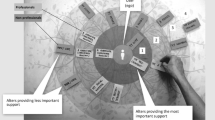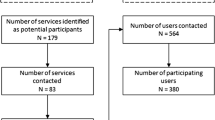Abstract
Recent advances in the care of the chronically mentally ill in the community have resulted in a “community support system” approach to maintaining chronically mentally ill persons outside the hospital. Yet, very little is known of what a community support system actually is for the chronic mental patient. This paper looks at three different sorts of community support programs and compares a sample of patients within them with respect to network variables, role performance, and demographic variables. Implications regarding the use of network oriented approaches are discussed and directions for further research are explored.
Similar content being viewed by others
References
Beels C.C., (1981). Social support and schizophrenia.Schizophrenia Bulletin, 7, 58–72.
Beiser M., (1974). Components and correlates of mental well-being.J. Health Soc. Behav. 15, 320–327.
Boissevain J., (1974).Friends of friends: Networks, manipulators, and coalitions. New York: St. Martins Press.
Bradburn N.M., (1979).The structure of psychological well-being. Chicago: Aldine.
Breier A. & Strauss J.S., (1984). The role of social relationships in the recovery from psychotic disorders.American Journal of Psychiatry, 141, 949–955.
Carpenter W.T., Strauss, J.S., & Bartko, J.J. (1974). The use of signs and symptoms for the identification of schizophrenic patients: A report of the International Pilot Study of Schizophrenia.Schizophr Bull 11, 37–49.
Crowne D. & Marlow D. (1965).The approval motive. New York: John Wiley & Sons, Inc.
Cutler D.L. & Tatum E. (1983). Networks and the chronic patient. InEffective aftercare for the 1980s. David L. Cutler, M.D., (Ed.)New Directions for Mental Health Services, 19, 13–22, San Francisco: Jossey Bass.
Cutler D.L. (1984). Networks. Chapter 17, inThe chronic mental patient, five years later. John Talbot (Ed.), Orlando, FL. Grune and Stratton.
Derogatis, L.R., Lipman, R.S., & Covi, L. (1973). SCL-90: An outpatient psychiatric rating scale: Preliminary report.Psychopharmacol. Bull. 9, 13–27.
Hammer M. (1981). Support systems, social networks, and schizophrenia.Schizophrenia Bulletin, 7, 45–75.
Harding, C.M., Brooks, G.W., Ashikaga, T., Strauss, J.S., & Landert, P.D. (in press). Aging and social functioning in once-chronic schizophrenic patients 21–58 years after first admission: The Vermont story. In Hudgins & Miller (Eds.),Schizophrenia, paranoia, and schizophreniform disorders in later life. New York: Guilford Press.
Hurd, Pattison, & Smith. (1981). Test-retest reliability of social network self-reports the Pattison Psychosocial Kinship Inventory (PPI) Paper presented to the Sun Belt Social Network Conference, Tampa, Florida, Feb. 20–21.
Katz & Lyerlie. (1963). Methods for measuring adjustment and social behavior in the community: Rationale, description, discrimination, validity and scale development.Psychological Reports, 13, 503–507.
Lamb, H.R. (1982). Young adult chronic patients: The new drifters.Journal of Hospital and Community Psychiatry, 33, 465–468.
Pattison, E.M., DeFrancisco, D., Wood, R., Frazer, H. & Crowder, J. (1975). A psychosocial kinship model for family therapy.American Journal of Psychiatry, 132, 1246–1251.
Pattison, E., Lamas, R. & Hurd, G. (1979). Social network mediation of anxiety.Psychiatric Annals, 9, 474–482.
Schwartz S.R. & Goldfinger S.M. (1981). The new chronic patient: Clinical characteristics of an emerging subgroup.Journal of Hospital and Community Psychiatry, 32, 470–474.
Sokolofsky, J., Cohen, C., Berger, D. & Geiger, J. (1978). Personal networks of ex-mental patients in a Manhattan SRO hotel.Human Organization, 37, 5–15.
Strauss, J.S., Hafez, H., Lieberman, P. & Harding, C.M. The course of psychiatric disorder, III: Longitudinal principles.American Journal of Psychiatry,142, 289–296.
Tolsdorf, C.C. (1976). Social networks support and coping, An exploratory study.Journal of Family Process, 4, 407–417.
Author information
Authors and Affiliations
Rights and permissions
About this article
Cite this article
Cutler, D.L., Tatum, E. & Shore, J.H. A comparison of schizophrenic patients in different community support treatment approaches. Community Ment Health J 23, 103–113 (1987). https://doi.org/10.1007/BF00757164
Issue Date:
DOI: https://doi.org/10.1007/BF00757164




